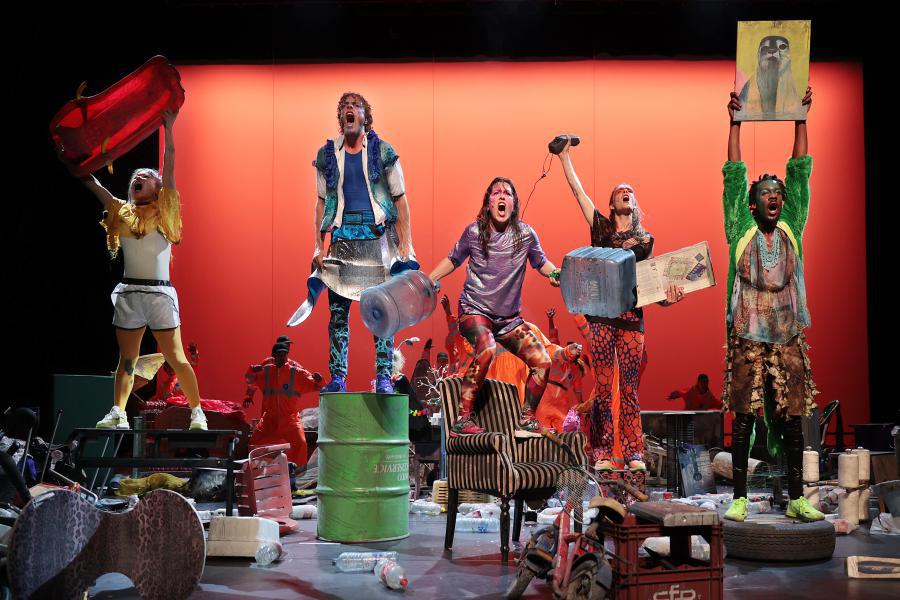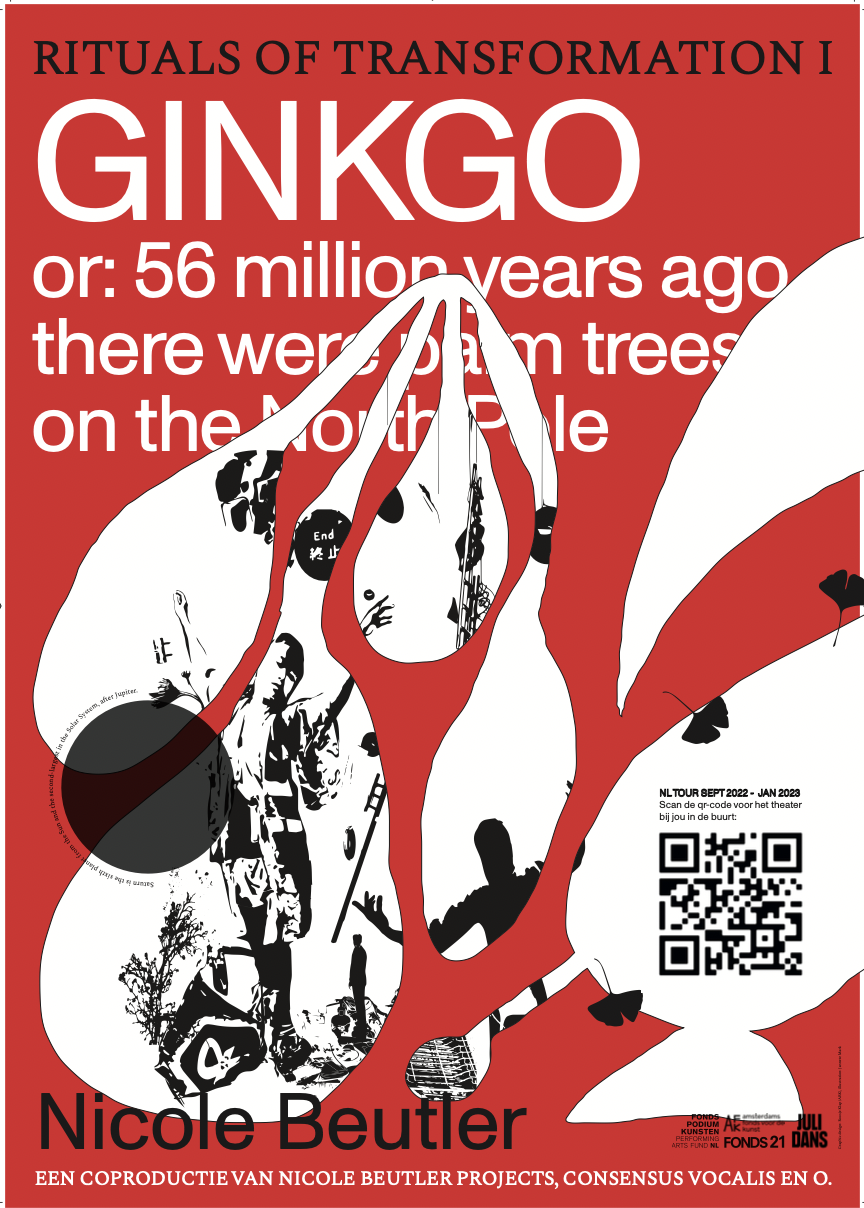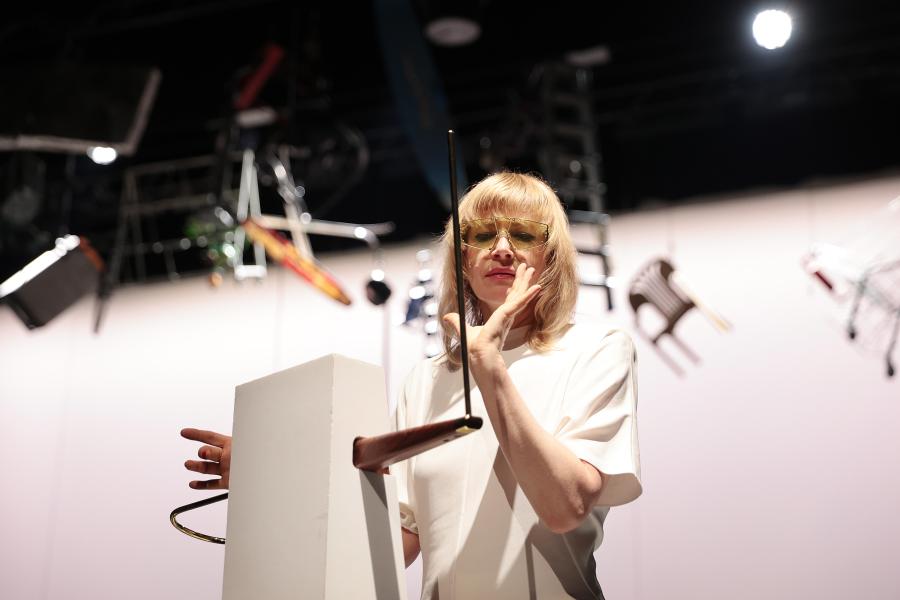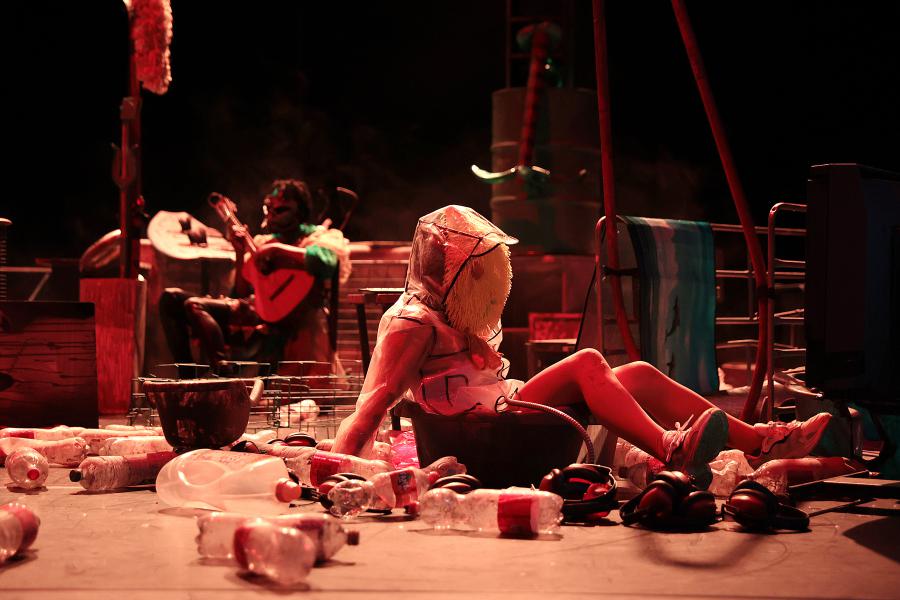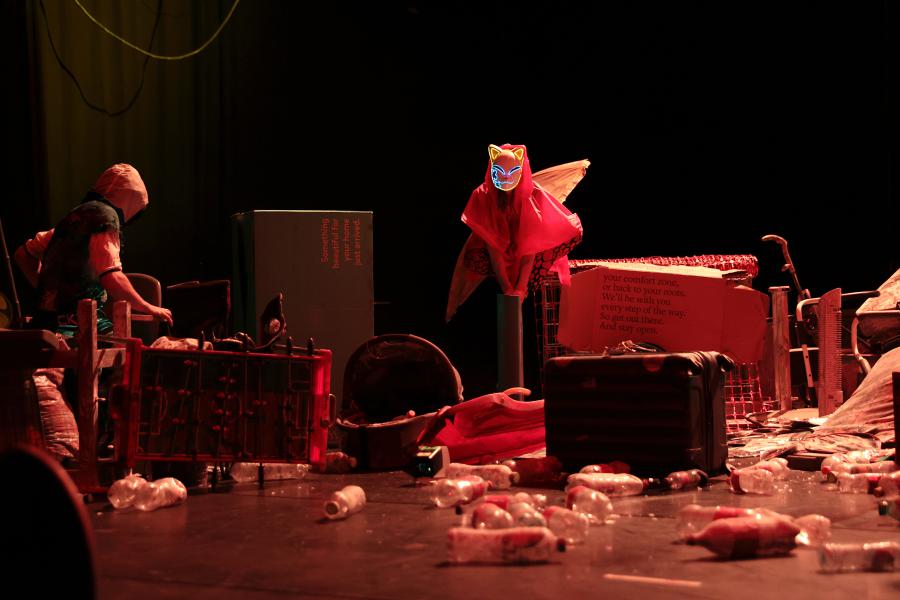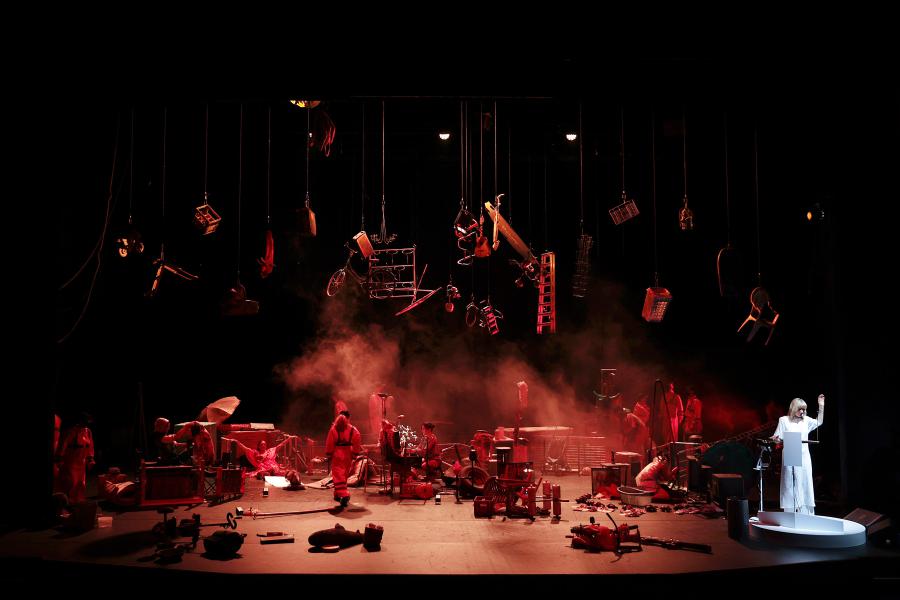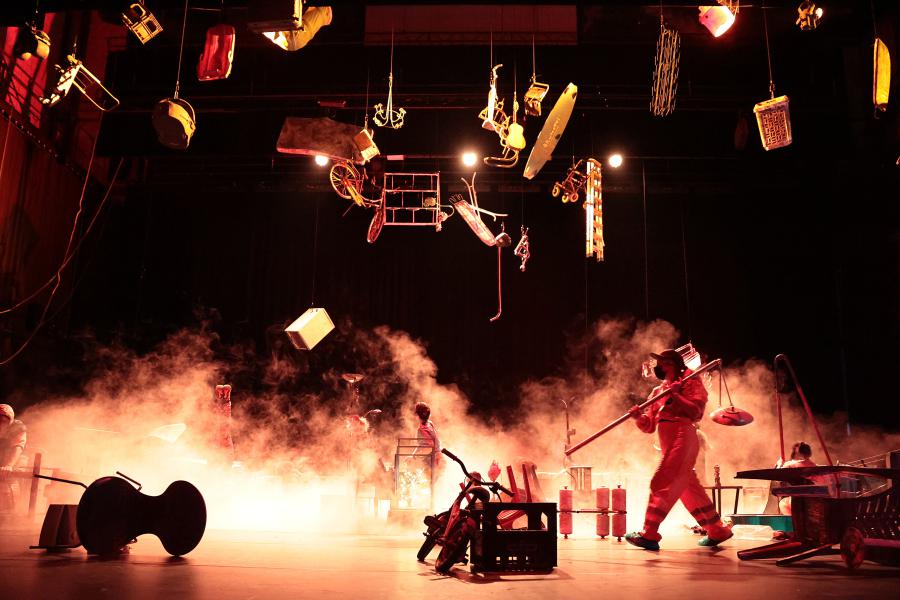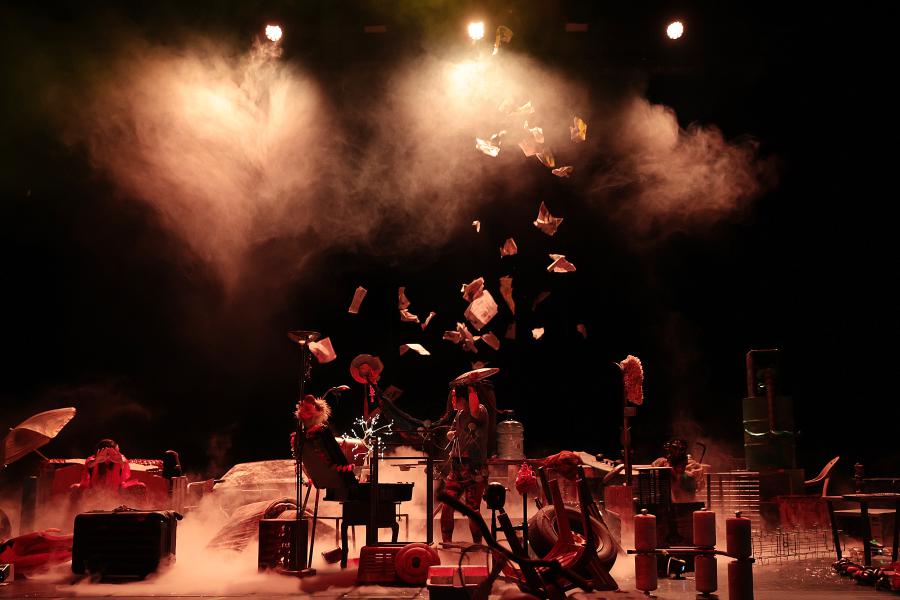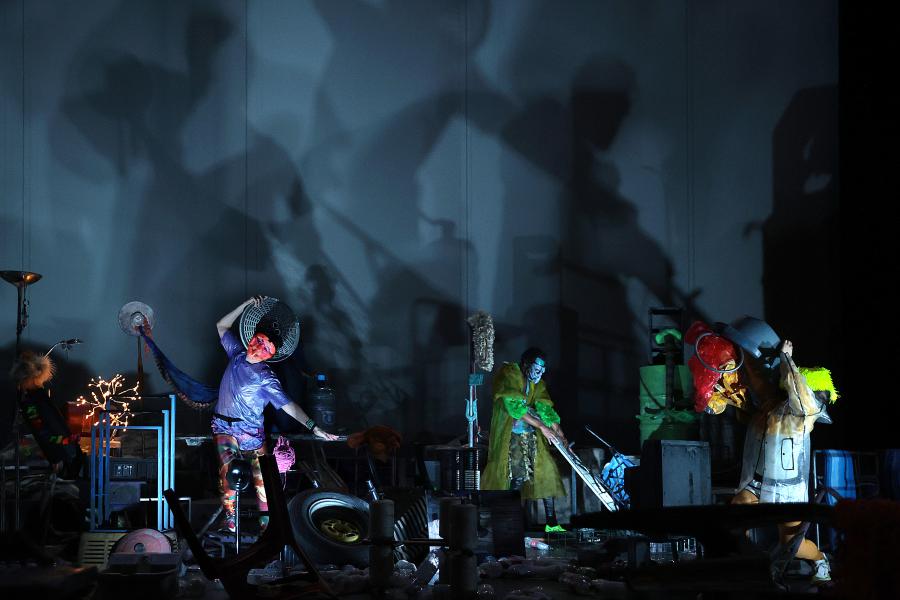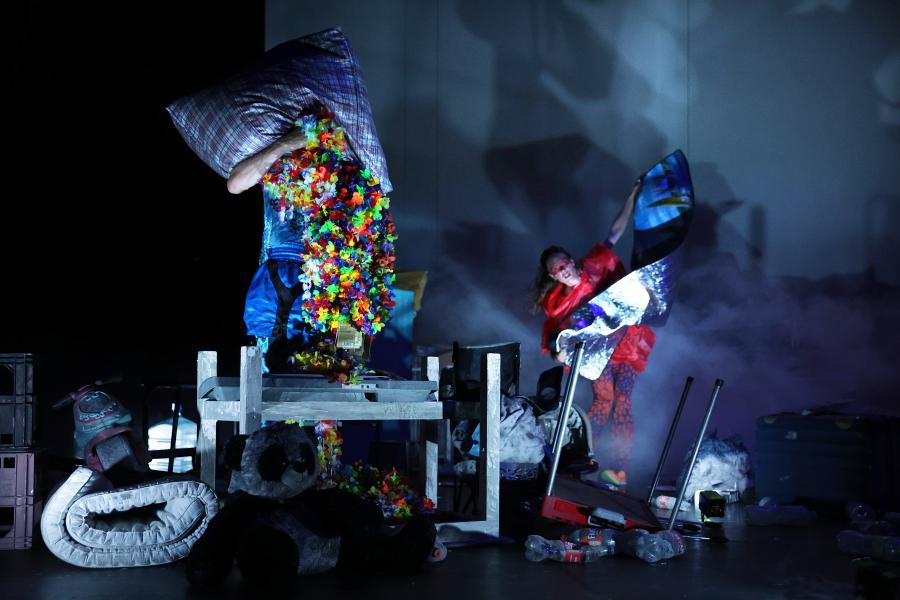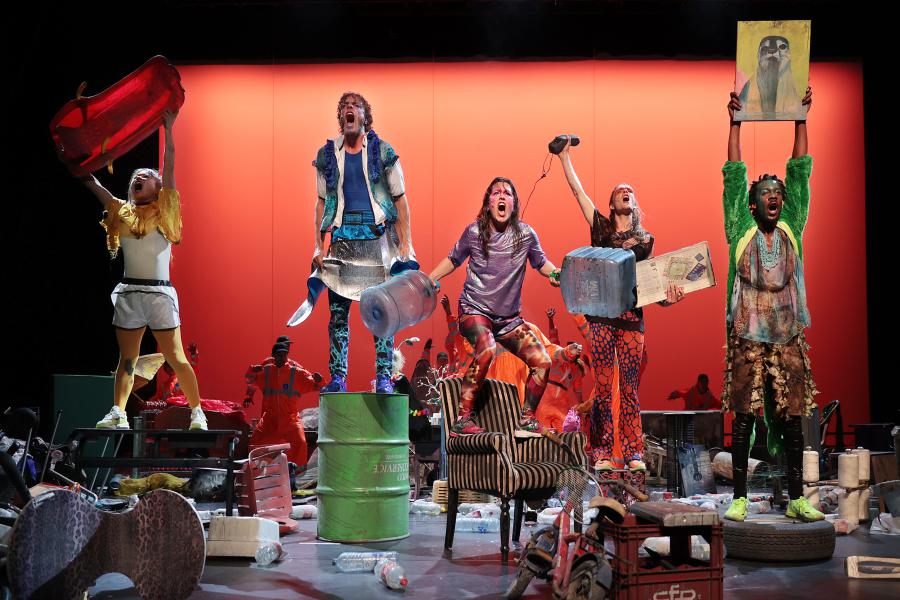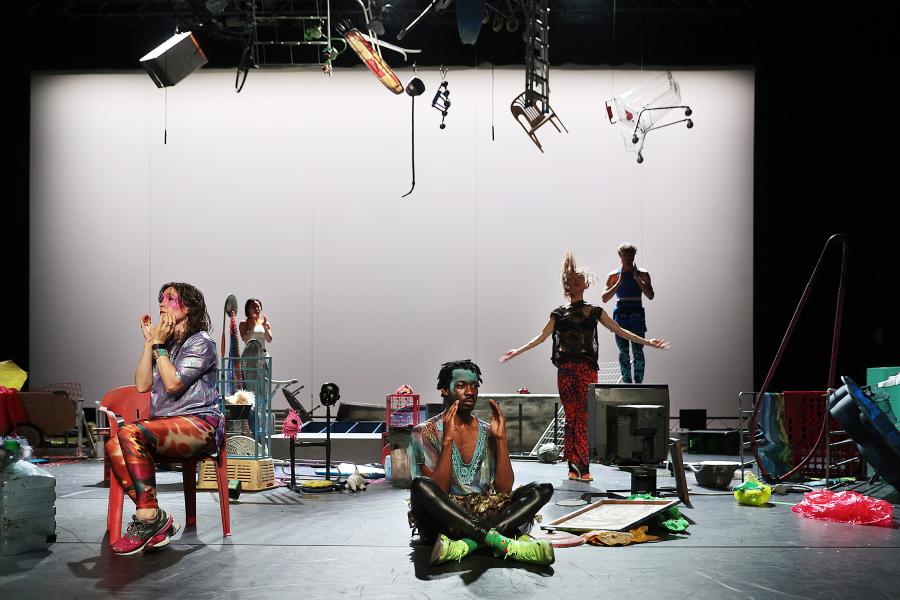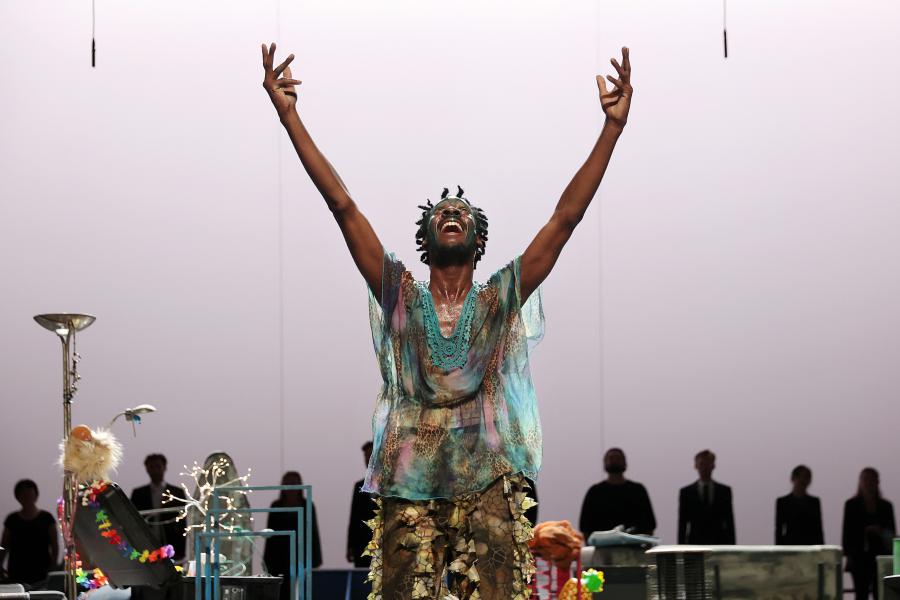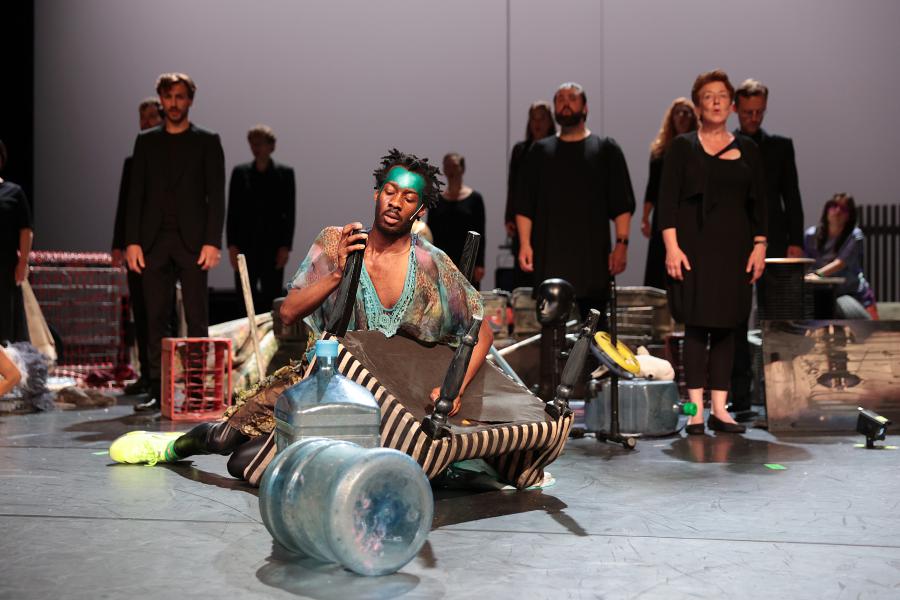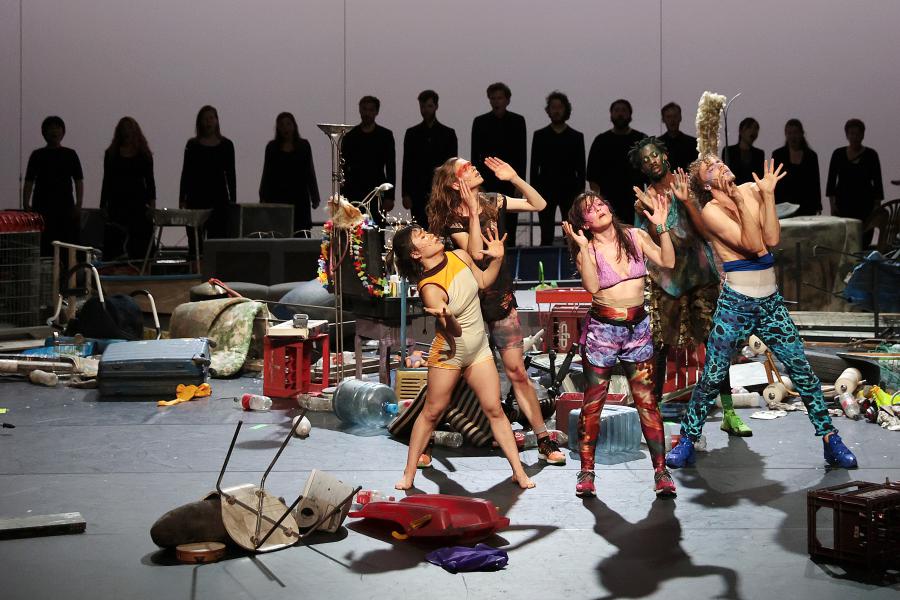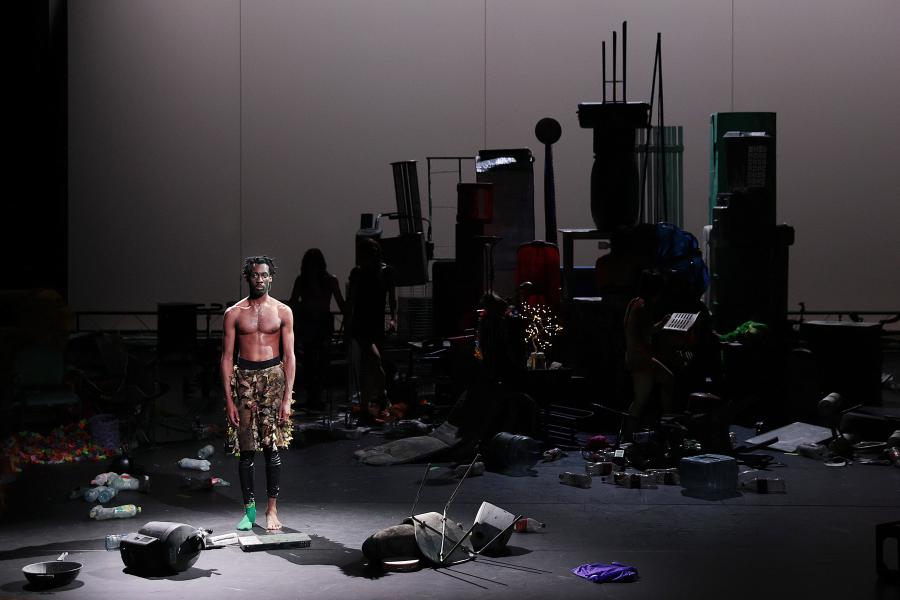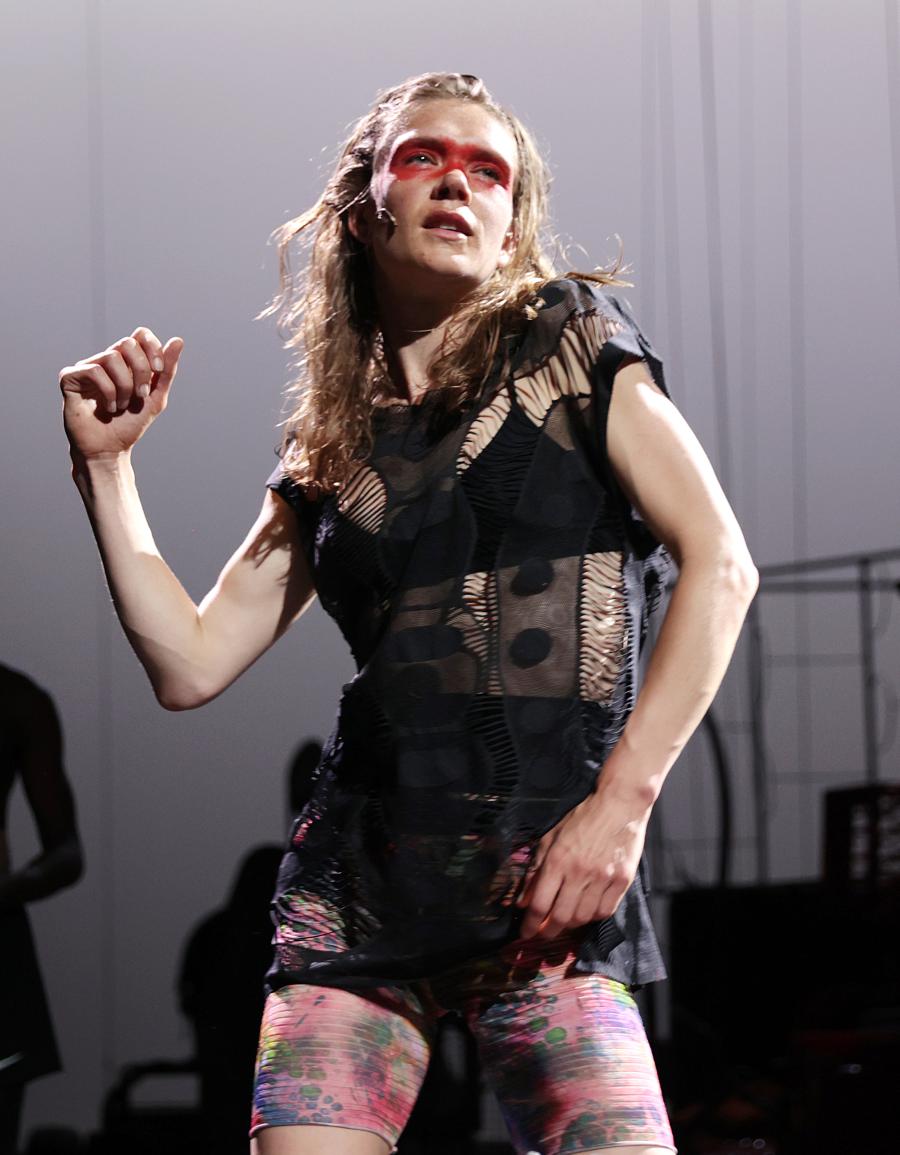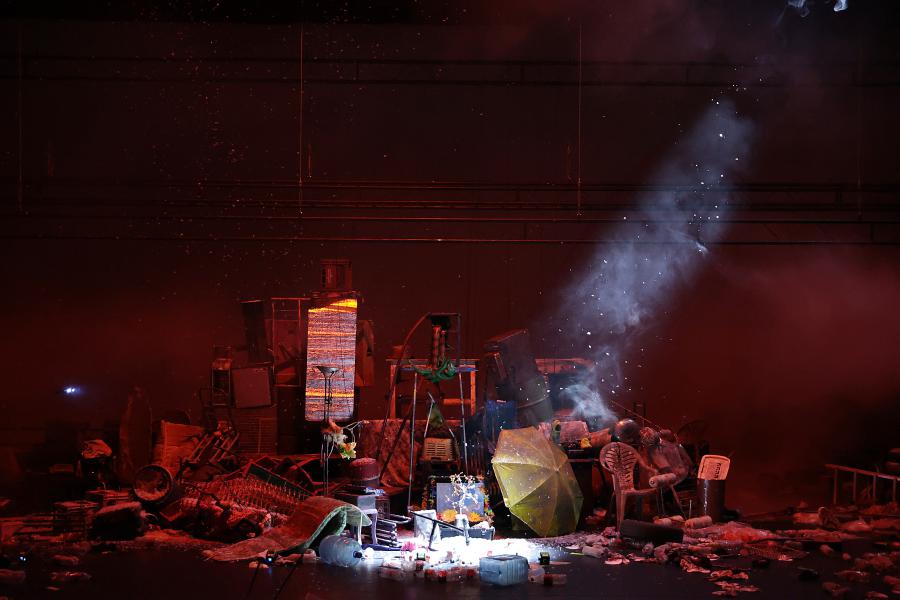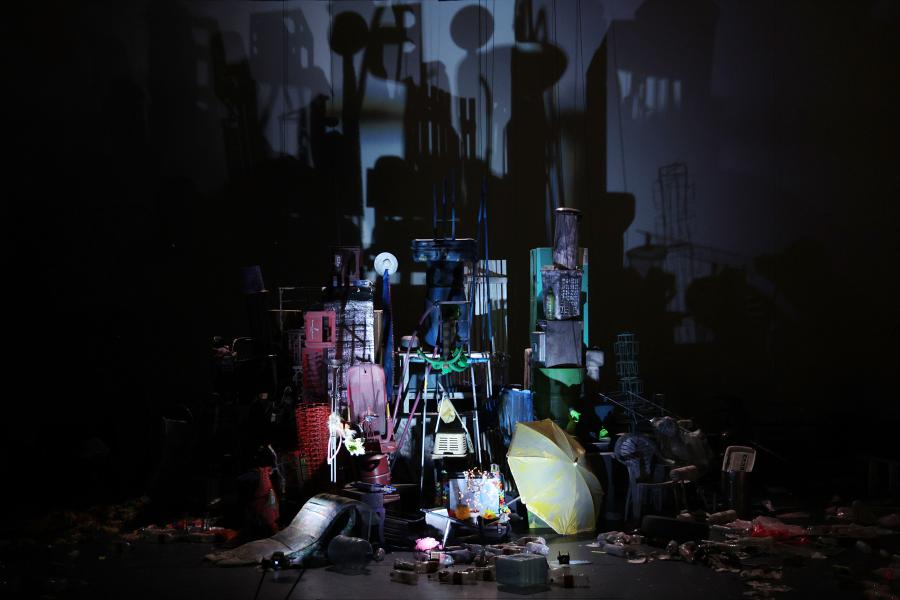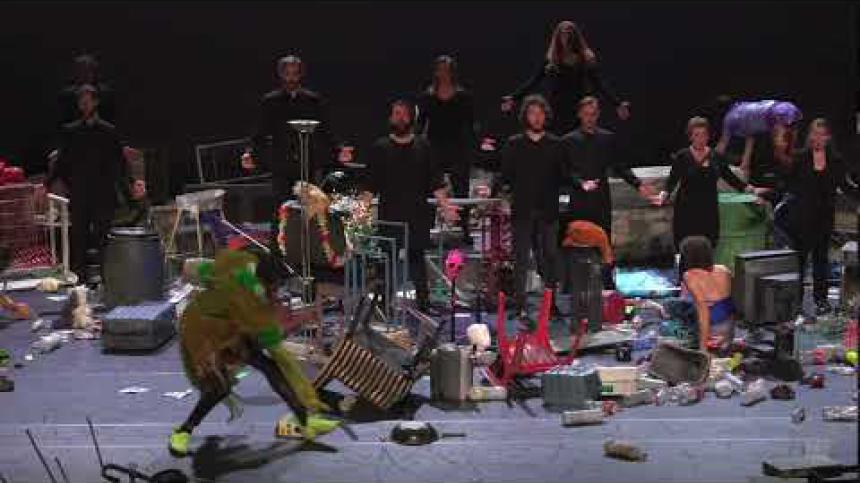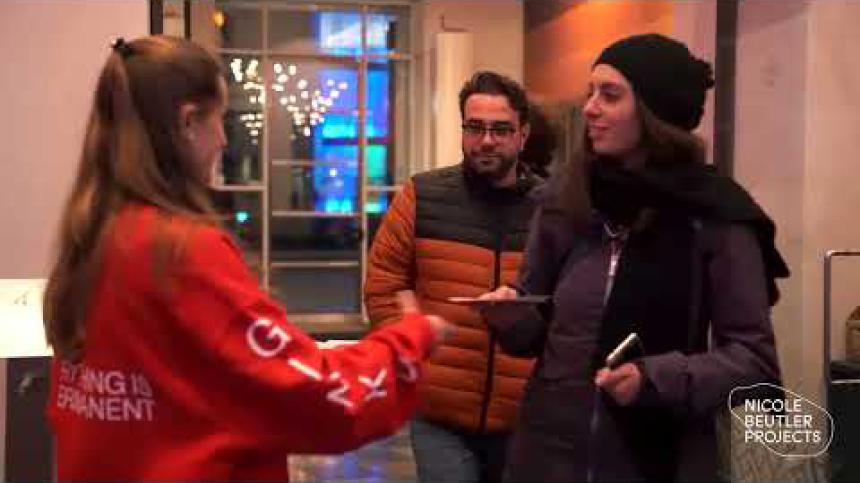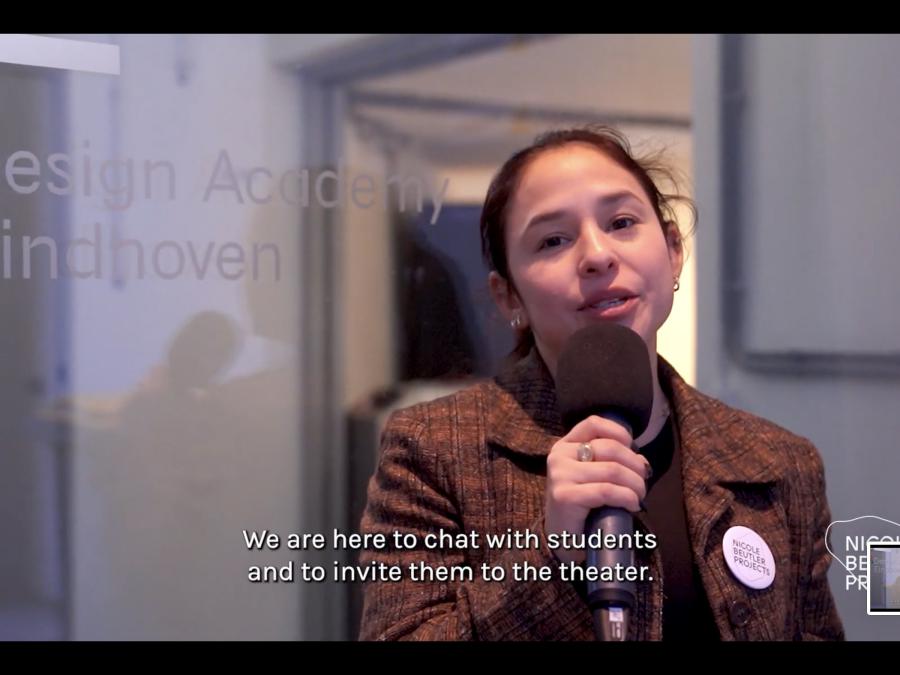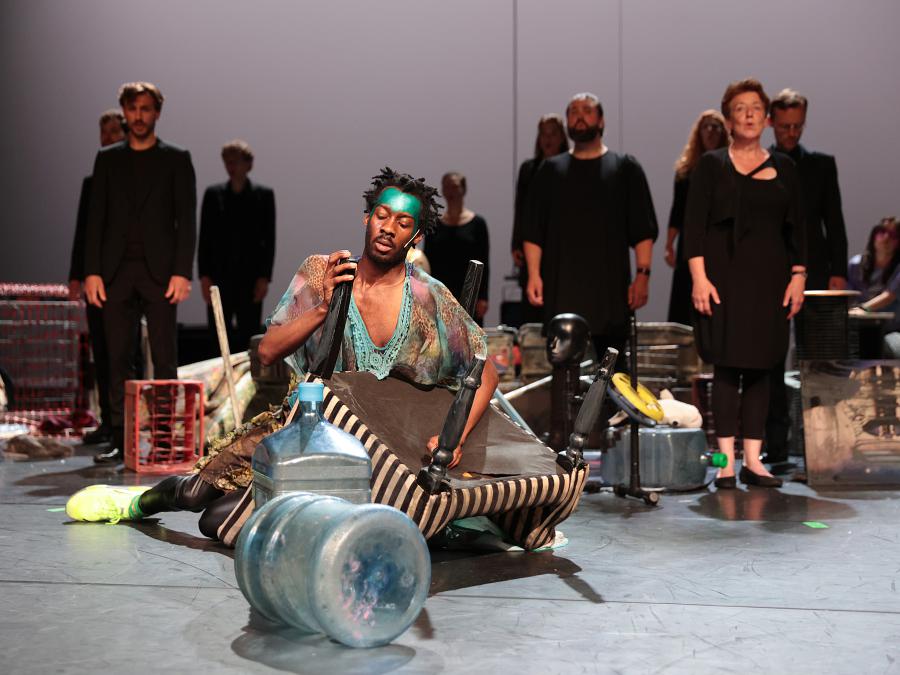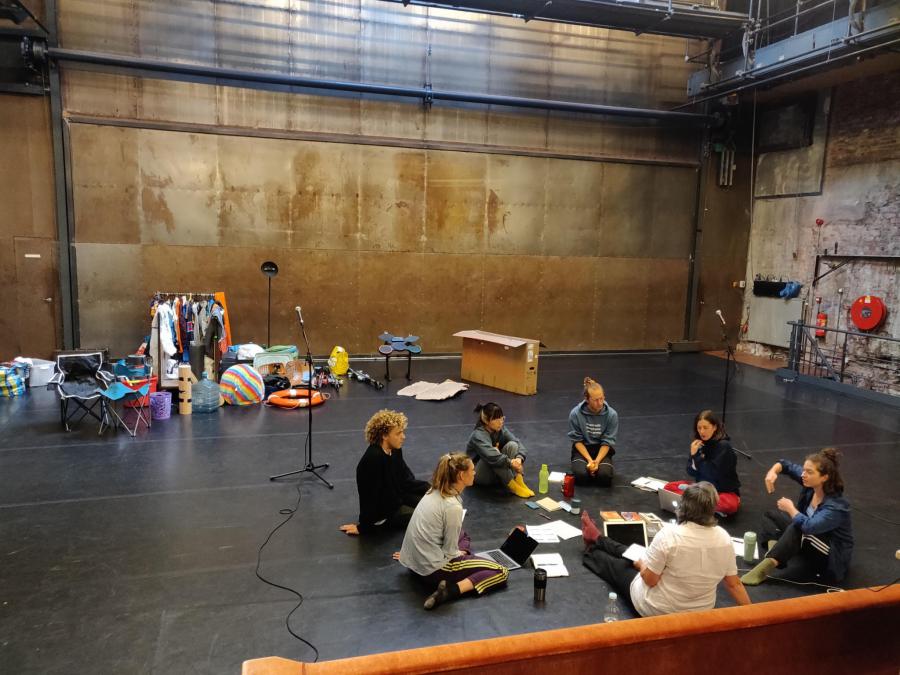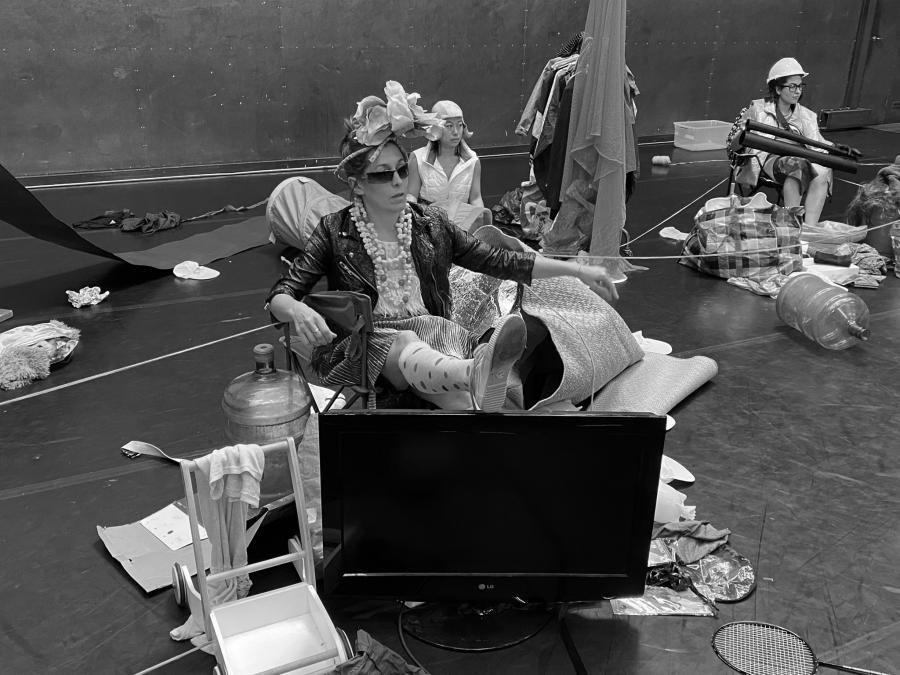GINKGO or: 56 million years ago there were palm trees on the North Pole
In GINKGO or: 56 million years ago there were palm trees on the North Pole we say goodbye to the world as we know it; dancing on the garbage heaps of our civilization as melancholic pieces of music from our collective memory slowly distort and fade away.
What if everything collapses.
What if humanity drowns in their own waste.
What if the earth reclaims her space.
After the great success of dance opera 8: METAMORPHOSIS, choreographer Nicole presents another visual Gesamtkunstwerk. With GINKGO or: 56 million years ago there were palm trees on the North Pole, the first part of the trilogy RITUALS OF TRANSFORMATION, she faces the fear of the possible end of humanity. The title is derived from the ginkgo, a Japanese nut tree that can now also be found in many places in the Netherlands. A symbol of primeval strength – at the time, the ginkgo even withstood the nuclear explosion in Hiroshima. GINKGO or: 56 million years ago there were palm trees on the North Pole is one last ecstatic dance on the garbage heaps of civilization.
Gary Shepherd’s futuristic music compositions form the cinematic guideline, theremin-player Dorit Chrysler is master of ceremony, and the twelve singers of Consensus Vocalis recall a lost era with Mozart’s Lacrimosa. Saying goodbye hurts, but when we let things go, there is space for new perspectives and unexpected beauty.
With this trilogy Beutler invites her spectators to rehearse the future. In part 2 ATMEN / evolution is silently unfolding nature shall get its breath back and a few surviving humans and hybrids will form a new community in the theatre as an enchanted forest. in part 3 we will be looking for a healing balancing act between humans, animals, plants, mycelium and technology.
Listen to the introduction:
REVIEWS
-
GINKGO is disturbingly beautiful
Nicole Beutler produces performances on current topics at a fast pace. Often with a troubled undertone. How do we keep each other trapped in rules and mindsets? How can we not see where the planet is heading if we don't act now?
The latter made her decide to make a trilogy on that subject; Rituals of Transformation. Ginkgo is the first of these. The first part of a trilogy where the issue is outlined inescapably.
Inevitable it is indeed. The stage is full of rubbish, it is a kind of apocalyptic landscape where a few try to survive and where old junk also falls from the sky, even an avalanche of bottles, where a bicycle and a shopping trolley hang there as evidence of careless handling of each other and the resources. It is an intriguingly bleak picture. The whole performance takes place in between. This makes this Beutler less of a dance performance than the others. There is hardly any place. However, where it happens and particularly the dying swan is of a timeless beauty.There is also a hopeful image. Like some kind of archangel, Dorit Chrysler, dressed entirely in white, plays the theremin. Her ethereal soothing presence and the wonderment evoked by this intriguing instrument form a fine contrast and resting point in the desolate chaos.
Altogether, it is a poignant yet comforting performance. With the singing of Nederlands Kamerkoor as the absolute highlight. The poignant Lacrimosa from Mozart's Requiem. (But why was the text changed? Replacing Jesu Christe with Gaya is redundant and unnecessary) It is an indictment and a caress at the same time. Here Beutler is at her best, as she was in Dido Dido, in my experience her best performance ever. Music, movement and message dance around each other, leaving the viewer enraptured. After a series of texts, it culminates in an urgent message: There is still time. With that, the other texts actually become superfluous.
Then something remarkable happens. The dancers disappear. The stage becomes snowy, crackling music sounds and it takes a long time. Very long. The room becomes restless. A light moves, eventually finding peace on a small plant growing through the chaos. A beautiful symbol, but after Chrysler's words and her departure, the performance was at its peak. Is this long last act the way to make the urgency felt? I fear not.But, either way, the whole thing makes one curious about parts 2 and 3, both in form and content. But perhaps with a little more room for the viewer to think for themselves, instead of already spelling out the problem and the need for a solution in multiple ways. The power and beauty of parts of this show deserve to be highlighted in full, and that does not detract from the message.
By Elise Kant
-
Revolutionary energy on a mountain of waste
Anyone who can be found with any regularity on a beach somewhere on the Atlantic, whether near IJmuiden or in Lomé (West Africa), cannot have failed to notice it. The seas are rapidly turning into highways for gigantic container ships that loom on the horizon in endless traffic jams as far as the eye can see. Articles appear in (foreign) newspapers about how business is excitedly speculating about melting ice caps that could enable faster sea transport between continents. What can a performing artist do against this violence?
Nicole Beutler takes up the gauntlet in the first part of what is to be a trilogy: Rituals of Transformation I: Ginkgo. The Japanese tree that gives this show its title is the only living organism that managed to defy the atomic bomb. The performance begins in post-apocalyptic atmospheres: an orange sun rises against an inky black sky, illuminating a landscape like an exploded industrial site. Among oil drums, worn armchairs, suitcases, water bottles, bicycles, racks, and indefinable fragments of overconsumption, the dancers scurry. A backdrop descends with an idyllic park landscape, but it is only a fleeting memory of what a landscape once was and the canvas quickly disappears, leaving the inhabitants to their fate in their fragmented metropolis.
In this waste, the dancers indulge in short dances of a spastic nature. At regular intervals they seem to address the heavens in an urgent prayer, and here and there we see an attempt to escape, to fly away. The shadows they cast at times form silhouettes of hybrid creatures, between object and human.
From the outset, on the right of the front stage, a sovereign, spiritual presence dressed in white is commenting on events and guiding them on that wondrous instrument that must be played while dancing: the theremin. Its controlled and effective playing by Dorit Chrysler forms a permanent balance against the desperate chaos on stage.
Halfway through the performance, the inhabitants of this world come together and unite in a revolutionary energy, screaming loudly at the audience as they carry objects with them. A choir dressed in black sings an edited version of the lacrimosa from Mozart's requiem, a repeated mourning lament.
The final part of the performance is a series of individual statements by each of the dancers. They seem to be personal statements taking a stand against the violence that surrounds them. The calm and concentrated sincerity with which Cesirhe Sedney speaks his farewell text impresses amid the more intense monologues by Hilary Blake Firestone, Melyn Chow and Felix Schellekens and the unexpected Dutch by Marjolein Vogels.
During these monologues, a new country/city is built up leading to the final scene: as a mutilated version of Saint-Saëns' Le Cygne resounds, a steady snow descends over the collapsed remains from which all life seems to have vanished. Or has it?
Beutler packs a big punch and the chosen theme fully justifies this approach. Marloes and Wikke are the ideal designers for this project, they create strong images: the stream of PET bottles clattering on the floor with accusatory noise reinforces the eloquence of the performance. The texts used, on the other hand, do not always succeed in getting to the heart of the argument and sometimes lack the impact that the images do. They come from obvious (Morton) and perhaps less obvious sources (Shakespeare, Rinpoche), but - unlike the dancers' monologues - they create a certain analytical distance from the rest of the scene material.
They become footnotes to the action and join the main text only with difficulty. Engagement and analysis are thus offered side by side, and the viewer has to switch and go along with the story or reflect on the analysis. This is what the performing artist is capable of. Beutler does not want to be pessimistic, so the last text that sounds is 'there might still be time'. The closing image fits this seamlessly and opens the way to the second part of this trilogy in the making.
Read the article on Theaterkrant.nl here.
-
A passionate, well-argued and skillfully executed case warning of the destiny that awaits us.
The ginkgo tree, although a native of China, is not uncommon in Europe. It is the last living species in the order Ginkgoales, which first appeared over 290 million years ago. It is a survivor, outliving the dinosaurs and snubbing its nose at plagues, famines, pestilence and everything that Mother Nature and humans threw at it.
Nicole Beutler’s eponymous new work observes that mankind is less of a survivor, that we are all doomed, or might be. Ginkgo, sub-titled A farewell to the world as we know it, is the first in a proposed trilogy, Rituals of Transformation. But it’s not all gloom and doom – in the second part, we are told, nature will breathe again and the final act is a healing balancing act between humans, animals, plants, mycelium and technology.
Beutler’s Ginkgo is a sort of performance version of Blade Runner set, post-apocalypse, amid the detritus of a broken world. Part Extinction Rebellion protest, part Greta Thunberg rally but all unrelenting, in-your-face, hi-octane total theatre, Ginkgo is a piece that is hard to ignore.
We were taken through the proceedings by a lone lady downstage left with her skilfully played ring modulator, supplying much of the music/soundscape. Dressed in immaculate, glowing white she provided a stark contrast to the dirt and grime around her, almost like a guardian angel sent to save us. She lectured, quoted and guided us through the catastrophe that in this case, had already happened.
The half dozen or so characters gradually emerged from the piles of rubbish while even more stuff hung ominously above them – old supermarket trollies, broken furniture, all the kind of stuff you’d find on your local rubbish tip. But this rubbish tip was their home, their only means of shelter and sustenance.
This was immersive theatre, part spoken word, part dance, part music. The ring modulator and Gary Shepherd provided most of the music but for me one of the most powerful moments of the evening was the appearance on stage of Consensus Vocalis, a choir smartly dressed in black singing Mozart’s haunting Lacrimosa. This provided a powerful and beautiful counter-point to the chaos through which they slowly wandered before leaving the stage through the auditorium.
The characters slowly began to put some order into the disarray by collecting up the garbage and making a huge pile of it upstage – a bonfire, an altar, a barricade? But even that collapsed onto a now uninhabited stage onto which snow, or was it ash? slowly fell.
The piece’s alternative title, 56 Million Years Ago There Were Palm Trees on the North Pole, I would have thought, demonstrated that climate change takes place even without man’s intervention. But that’s another argument. Nicole Beutler’s Ginkgo makes a passionate, well-argued and skillfully executed case warning of the destiny that awaits us. Let’s hope she is wrong. Michael Hasted 30th November 2022
NEWS & CONTEXT
-
Students Design Academy Eindhoven about the future
What role do they play as (future) designers? -
Discover the secrets behind GINKGO (podcast, 22 min)
Introduction, by artistic assistent Justa ter Haar -
GINGKO, work in progress ...
Beutler in residence in Grand Theatre Groningen
Cast & Credits
Concept, direction, choreography: Nicole Beutler
Created with the performers: Melyn Chow, Hillary Blake Firestone, Felix Schellekens, C’Cesirhe Sedney, Marjolein Vogels
Music: Gary Shepherd, W.A. Mozart, Camille Saint-Saens
Theremin composition + performance: Dorit Chrysler
Choir: Elma Dekker, Alice van de Geest, Kazue Goto, Kitty Lai, Carmen de Haan, Sarah van Lieshout, Ingrid van Ree, Felis Jago Larham, Aart Schutte, Leo de Visser, Bas Cornelissen, Sam Eggenhuizen, Hidde Kleikamp
Dramaturge: Igor Dobričić
Scenography: Marloes & Wikke
Lighting design: Minna Tiikkainen
Costume: Jessica Helbach
Repetitor: João Dinis Pinho
Assistant director: Catarina Ferreira da Silva
Voice lessons: Charles Hens
Ballet lesson: Alfredo Fernandez
Understudy: Djamila Ploeg, Rob Polmann
Sound: Valentijn Berkhout
Light: Prem Scholte Albers, Nicholas Hermans
Decor/ general tech: HP Hulscher
Musical director Consensus Vocalis: Béni Csillag
Production: Nicole Beutler Projects
Coproduction: Consensus Vocalis, O. Festival for Opera. Music. Theatre and Julidans
With support of: ITA, Opera Ballet Vlaanderen, Grand Theater Groningen
Made possible by: Fonds Podiumkunsten, Amsterdam Fonds voor de Kunst, Fast Forward, Fonds 21
Acquisition and tour planning: Theaterzaken via Rudolphi
With many thanks to: Goethe-Institut Amsterdam, Christian Guerematchi (first cast), Imre Ploeg NKK Next (research), Guy Cools (Boek Performing Lamenting), Toneelgroep Oostpool

